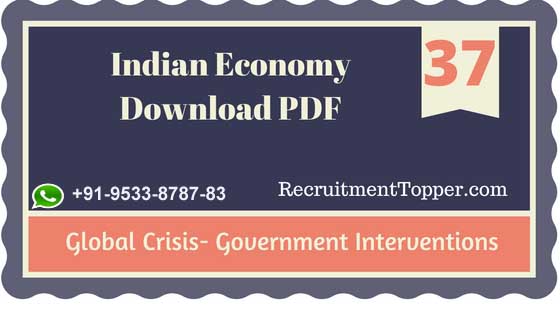Indian Economy | Global Crisis- Government Interventions Download PDF
Contents
Collective Intervention
A positive aspect post-global crisis has been the prompt and collective government level interventions unidirectional, which otherwise, was fraught with graver consequences, as mentioned previously, had the potential to surpass the agony of the great depression.
The government level interventions were first, avoiding any kind of panic but use collective wisdom. Secondly, at the government level itself, of that being ‘collective’ and ‘consensus’ driven unidirectional intervention. The third, being of its distinction made between direct and immediate, the other as indirect, in the medium-term and in the long-term, addressing structural issues of the global financial system, to prevent their recurrences in future. Fourthly, interventions would be short-term, as a medicine but need addressing the issues of the global financial system collectively, as part of the larger reform package.
Depending on the impact level, different governments could choose on the immediate intervention either as ‘bailout package’, which is providing government finances, capital infusion or as a ‘stimulus package’ driven around fiscal loosening. The US government resorted to bailout packages through capital infusion, also took over some of the institutions, relaxed its monetary stance by going for ‘quantitative easing’ and bringing down interest rates to near zero to revive growth and output of the US economy.
The Indian Government on the other hand resorted to a preventive-cum-stimulus measures like:
(1) RBI allowing banks to restructure their loan accounts and reschedule loan installments, as a preventive measure to prevent build-up of bad loans.
(2) It also went for quantitative easing by lowering CRR, to improve liquidity.
(3) It advised banks to shed their risk awareness, as it was a problem not a solution, to the slowdown in the economy.
(4) Fiscal measures as part of the stimulus package were, through rolling down excise duties and corporate tax rate to provide industrial sector necessary boost.
(5) It also ran up a high fiscal deficit by increasing spending in the economy, even at the risk of inflationary pressures and compromising on the compulsions under the FRBMA. In fact, India ran the highest fiscal deficit in the last 16 years.
(6) As a fillip to exports concessions were extended and new strategies of incentives were given to diversify to Afro—Asian countries impacted lesser by the crisis
Overall, it was a combination of all which limited the impact, without the need for any bailout as no financial institution in India had collapsed. Can we say that impact on India was fairly limited because of the public sector character of Indian financial system, less exposed to global markets?
Many critics feel so that public sector dominated financial sector was the reason for the limited impact. However, as mentioned previously, it was the timely intervention by the RBI and the government, without which, it could have resulted in collapse of some of the smaller banks even in the public sector. Banking globally has elements of risk. Any lending will have risks. But the answer to that is not to become risk averse.
The answer lies in growth and expansion by better risk assessment capabilities, risk diversification, have risk mitigants, understanding risk appetite and sufficient capital for the risk. The public sector character inherently has risk awarness and cautious approach, both of which are helpful in warding off crisis situations, but are also an impediment to expansion and growth of size of-banks, so important in developing risk appetite.
That is why despite India’s status as the fourth largest in the world, does not have any bank in the top fifty banks of the world, under any parameter, except may be the number people employed. So the larger question is not the ability to have withstood the global crisis and of having passed the test of time but what lies in future?
As India goes for deeper levels of integration, it would require mergers of banks to attain a critical mass and at some point will have to discard the public sector character, if it wants a few Indian large banks, actually becoming global banks and play a larger role in global financial system.

Leave a Reply